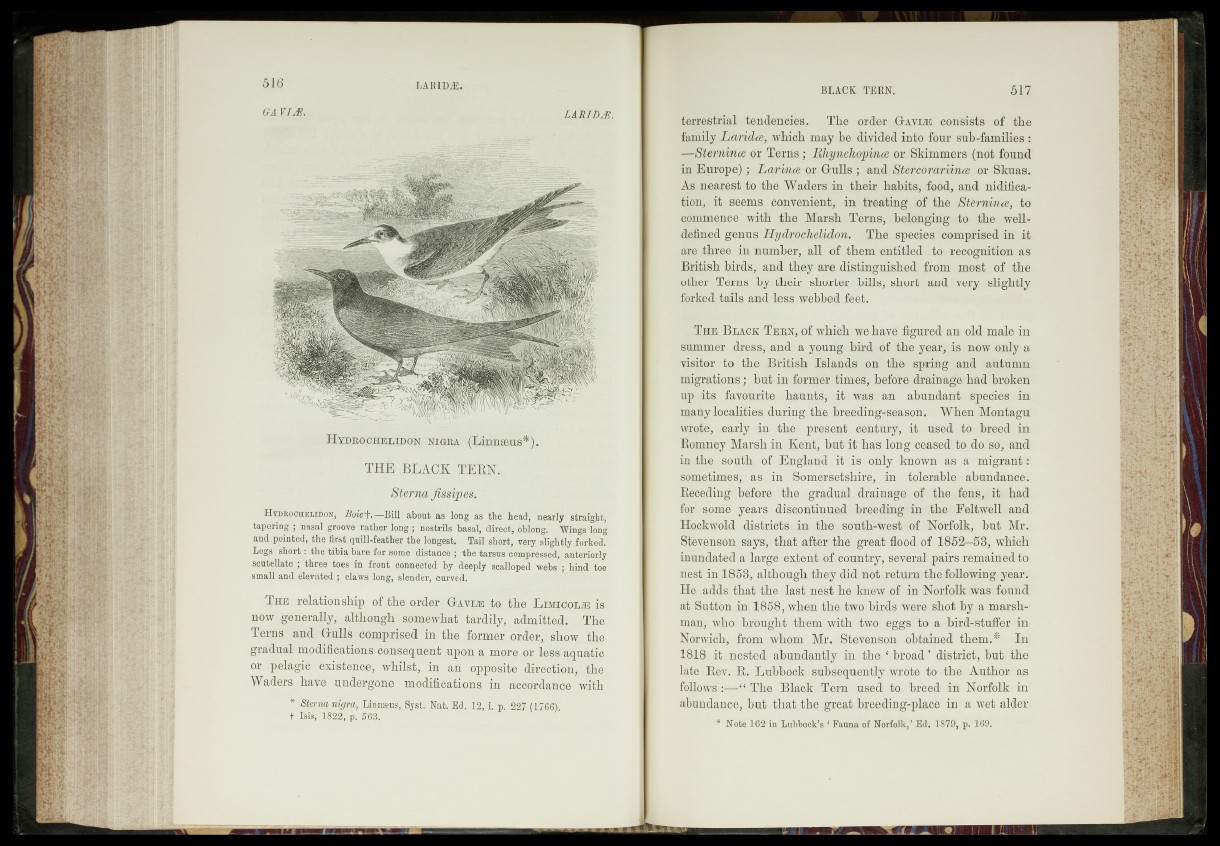
GA VIÆ. LARIDÆ.
H y d bo c h e l ïd o n --NHjtßA (Lin-næus*)s
THE BLACK TERN*
8 tevnazfi&sftp '4sG'2 ‘
Htdeoohblidon, Boief. — about as'long) as the head, nearly straight,
tapering ; nasal groove rathef’long;; ;nostrils basal, direct, obfbngS "Wings long,
and-pointed, the first Iquill-feather the longest. Tail'shicrt-, very slig h tly .^ r ie ll.
Legs sh o r t: the tibia bare for?some distance*;‘the tarsus cffmprmed,- anteriorly
scutellate ; three toes in |fo gn t _ cohne'cterd;;by deeply scalloped webaV h m O o e
small*and elevated ; claws long, Mender",’ curved!', [
Thu relationship of the order Gavl® ,to‘ the Limioolje^
now generally, although- gomewhat'tSrdily, admitted.^ The
Terns'and Gulls comprised in' th e^f^m^ o rd e^^ ow,;th e
gradual modifications, consequent upon a more or lejss^aquatic
or pelagic "existence-, whilst, iq jiS opposite^direction^E
Waders have undergorne mtidifiCationstm iaccordance with
* Sterna, nigra, Linnæus, Syst. Nat. EJ. 12, i. p. 227:(l?6ß).
t Isis, 18^2, p. S'es;’/ '
terrestrial tendencies. The order G avl® consists of the
family L'aridce, which may be divided into four sub-families:
rk-Steminee or Terns; Rhynehopinq^ov Skimmers (not found
in Eprope); Larince or Gulls ; and Sie-vcoravimte .or Skuas.
As nearest to the Wadersjn their habits, food, and nidifica-
tion; it seems convenient,- in treating -, oh the Stermrice, to
commence) with the Marsh Terns, belonging do the well-
defined genus 'HydfQchelidon. ■ The species comprised in i§
are three in number, all of them entitled to recognition as
British birds, and they are distinguished from most,' of the
other Terns, by .their shorter-bills,-short and very [slightly?
f©rked;tajls and less webbed sfeefe) §
The Black Teen, of which we have, figured an old male, in
summer dress, .and^a;young bird af the year, is now only a
visitor to the British Islands on the spring and autumn
migrations; Jbut inlormer times, before drainage had broken
up; its favourite, haunts, it was an abundantivspedies in
many localities during the breeding-season. When Montagu
wrote,. early in the ? present’ century^ used; to^ breed» in
Romney Marsh;in Kent; but.it has long ceased* to do so, and
in the [south' ibf -England-it is only known as a migrants?
sometimes,. a s " in iomeESetshia.5®, , in - tolerable1 abundance.
-Seeding ^before the .gradual drainage of the fens;, j it had
for^a(|gae;-years discontinued breeding in the Feltwell and
Haekwold in^ifele south-west of Norfolk, but,-Mr.;
Stevenson; says, that aftCr the great floodNoh 1-852-^-53, which
inundate.d'a large ektent of country, several pairs remained to«
tfesfe' in) lE58; although they did not return, the following year.
He. adds,thab|t%e-dastnest he knew of-medSToffelk was found
£^fS.iitton in 1858f;?wk@h theJ;w®£bi|d§swere> shot by a marsh-
man, who^rhaiought them^w^h?two-Tegg&!%o a bird-stuffier,in!
®^wich,>gfrom whom ?Mr* Stevenson obtained them.* In
1818 Anheetedfrnhundantly- in the-'! broad* district* but-the,
fej|et[-®e.y. R. Lubbo,e%vsnhs^Unhtly^wrdteJthi the Author as
followsTi—ikfEhei‘B-laek -Tern .-used to breed in Norfolk; ini-
abundancej'hukthattbe-great .-breeding-place in a .wet-aldeiv
* Note-I6 -LiibboekJV( Fauna-of Norfolk,’ Ed. p'. 1^6§.s- '*